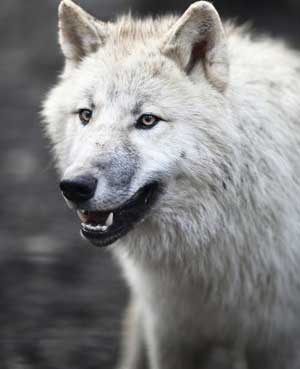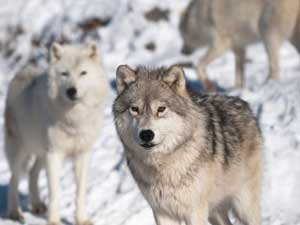Wolf Facts
Posted by A. Douglas / in Science Facts

Arctic Wolves have a white coat of fur
These wolf facts will help teach more about one of the most dangerous land predators. Some wolf facts, like the fact that wolves howl to communicate as well-known. There are also some wolf facts that kids may not know. For example, Red Wolves are basically extinct in the wild. Some red wolves were saved and reintroduced to North Carolina and the Great Smokey Mountains, but areas in the Southwestern United States where red wolves once thrived, no longer have red wolves. Find out many more wolf facts by reading on.
Wolf Facts - Predator Facts
- Wolves are extremely intelligent. They are the most intelligent predator. Many scientists consider wolves as much as 10 times more intelligent than the smartest dogs.
- A wolf has a great sense of smell. They can smell their prey up to 1.75 miles (2.8 kilometers) away.
- Wolves have great hearing. A wolf can hear their prey up to 6 miles (9.5 km) away through the forest and 10 miles (16 km) in the open. They move their head side to side until they determine the loudest point, which helps wolves know the direction of the sound.
- Wolves also have excellent eyesight, particularly at night. Their eyes have a reflective retina that allows much more visible light in dark conditions.
- Wolf jaws are very strong. With a crushing pressure of over 400 psi, their bite is nearly twice as powerful as the American Pit Bull and can crush the leg bones of a moose.
- Wolves are good swimmers. They are known to follow their prey through the water during a hunt.
- Their agility, speed, intelligence and senses make wolves one of the best hunters of all the land animals.
- Wolves are better hunters when they hunt in packs. Wolves often hunt in packs of 6 to 10 animals. They are then able to attack animals much larger than themselves.
Types of Wolves

Wolf Pack
- There are 2 types of wolves. The main two types of wolves include the gray wolf and the red wolf. There is a third animal called the manned wolf, which is more like a red fox.
- In North America gray wolves still live naturally in a few of the northern U.S. states and throughout Canada. They also still survive in Russia, Northern Asia and there some still left in Europe. Gray wolves are also known as the Arctic wolf, Mexican wolf, prairie wolf, tundra wolf and the timber wolf.
- Red wolves were very plentiful in the southwestern United States, but now only live as a re-introduced animal in North Carolina and the Great Smoky Mountains. Red wolves are also known as the southern wolf and the timber wolf.
- Adult wolves have no natural predators, except for humans. It is hard to believe this wolf fact, but Wolves once were very plentiful in North America with an estimated population in the millions. Today there may be less than one hundred thousand wolves in all of North America.
Physical Facts about Wolves
Wolves may look similar to dogs, but they have some features that are different from domesticated dogs.
- The average size of the male gray wolf is about 42 inches (1100 mm), not including the tail. Males wolves are larger than female wolves. The aver size of the female gray wolf is 41 inches (1050 mm).
- The average male gray wolf weighs 121 pounds (55 kg). The average female wolf gray weighs around 100 pounds (45 kg).
- Gray wolves are 10 to 50 percent larger than red wolves.
- Arctic Wolves have a white coat of fur.
- Gray wolves are the largest wild dog found in the world.
- Gray wolves have are wider nose and shorter ears compared to red wolves.
- Red wolves have shorter fur and proportionally longer legs and ears than gray wolves.
- Wolves have a top running speed of approximately 43 miles per hour (70 km per hour).
- Gray wolves have a wide range of fur coloring. They range from black to white with variations of brown, tan, silver and red. Wolves located in the far north are sometimes referred to as Arctic wolves, although they are gray wolves. Arctic wolves are generally have white fur.
- Red wolves have a reddish fur coloring with variations of white, brown, gray, silver and tan.
- It is a well-known fact that wolves live in packs.
- The typical size of a wolf pack may be 4-12 wolves.
- Wolf packs are very social and have an order. The leaders of the pack are the alpha male and alpha female. They decide where the other wolves go and look out for the other wolves. The alpha pair helps keep the pack working as a group.
- Traveling and hunting in packs helps the wolves work together to capture more food.
- When wolves howl, they are actually talking to each other or warning other wolves to stay away from their territory.
- The wolf pack also helps look out for baby wolf pups after they are born.
- Sometimes wolves leave their pack. Since most other packs will not accept a new wolf, these wolves either find other wolves or become a lone wolf.
Wolf Facts: Wolf Packs
